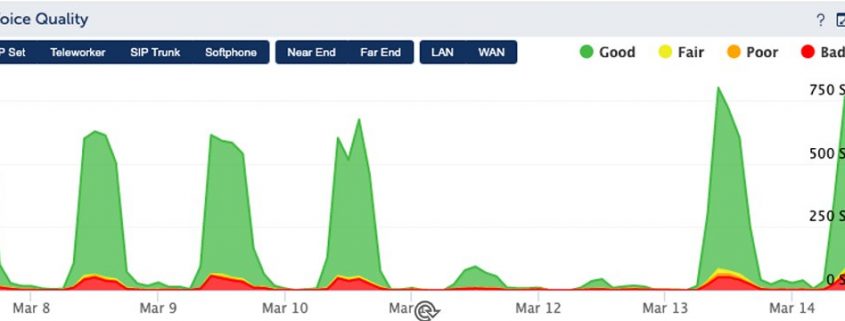Excellent Voice Quality is Critical for Hybrid Work
In our current ‘work from anywhere’ world, a good chunk of the population has come to rely on smartphone apps and softphones to stay connected. This means delivering the best Voice Quality (VQ) possible has never been more critical.
For IT teams, guessing the VQ user experience can be like flying in the dark. You think it is ok, but do you know how users are actually experiencing their VQ? If a user complains about VQ, can you quickly determine the root cause? Can you measure the severity and impact of that poor quality?
3 Reasons why delivering good VQ in a hybrid work world can be challenging…
1. Inconsistent Technology – With some employees working from home and others in the office, there can be inconsistencies in the technology used for communication, including several different platforms and devices. Add apps and softphones to the mix, and gaining visibility into performance takes a lot of work.
2. Connectivity Issues – Remote workers may experience connectivity issues due to poor internet connections, leading to delays or dropped calls, which can affect the quality of the call. Finding workarounds to poor performance is very common and can include dropping videos, not sharing, and even resorting to a cell phone to complete a call.
3. Lack of Environmental Control – When employees are in different locations, it can be challenging to control their work environment. For example, they may need access to high-quality microphones or headsets in certain situations. In other cases, the environment can be a challenge, from a noisy open workplace to parents working from home with children or a remote worker trying to take a meeting in a crowded coffee shop.
The consequence of all these issues is poorer interaction and an opportunity lost to close a ticket or make a deal properly. VQ is not only about user satisfaction or comfort but also about user productivity and business efficiency and success.
You can take steps to mitigate these challenges and improve the hybrid work VQ experience with Mitel’s MPA Tools…
- Mitel Performance Analytics (MPA) – This fault and performance management solution proactively monitors and manages your entire network. Its deep analytics can help answer any question that you might have about overall performance and VQ. It can also quickly identify VQ and network quality concerns before business-affecting outages arise.
- Extended VQ Monitoring for Quick Troubleshooting – MPA includes deep VQ cause visualization capabilities that include VQ correlation graphs that quickly point you toward the root cause of a problem, allowing you to spot trends. Detailed reports help quickly identify and assess VQ. Reports demonstrate performance and help with forecasting, planning, and load balancing. MPA also delivers detailed information that can be easily shared with key stakeholders, including in-depth reporting for softphone VQ in MPA Plus.
- MPA Plus – This tier ensures that mobile and desktop MiCollab softphone VQ are captured in MPA. This data is fully integrated into the existing MPA VQ analysis and reports. MiCollab Mobile Clients (Android, iOS) and MiCollab Desktop Client (Windows or MAC) are supported. MPA includes VQ cause visualization trunk traffic and MiCollab audio, web, and video (AWV) utilization reports to beef up capacity for better performance. These reports are easily downloaded and shared, and you can also see usage reports for AWV.
Download the Mitel MPA Brochure here
Take the guesswork out of determining the VQ user experience… Overcome performance challenges with Mitel’s MPA Tools. Contact TCI at (703) 321-3030 or GetHelp@tcicomm.com.













Leave a Reply
Want to join the discussion?Feel free to contribute!